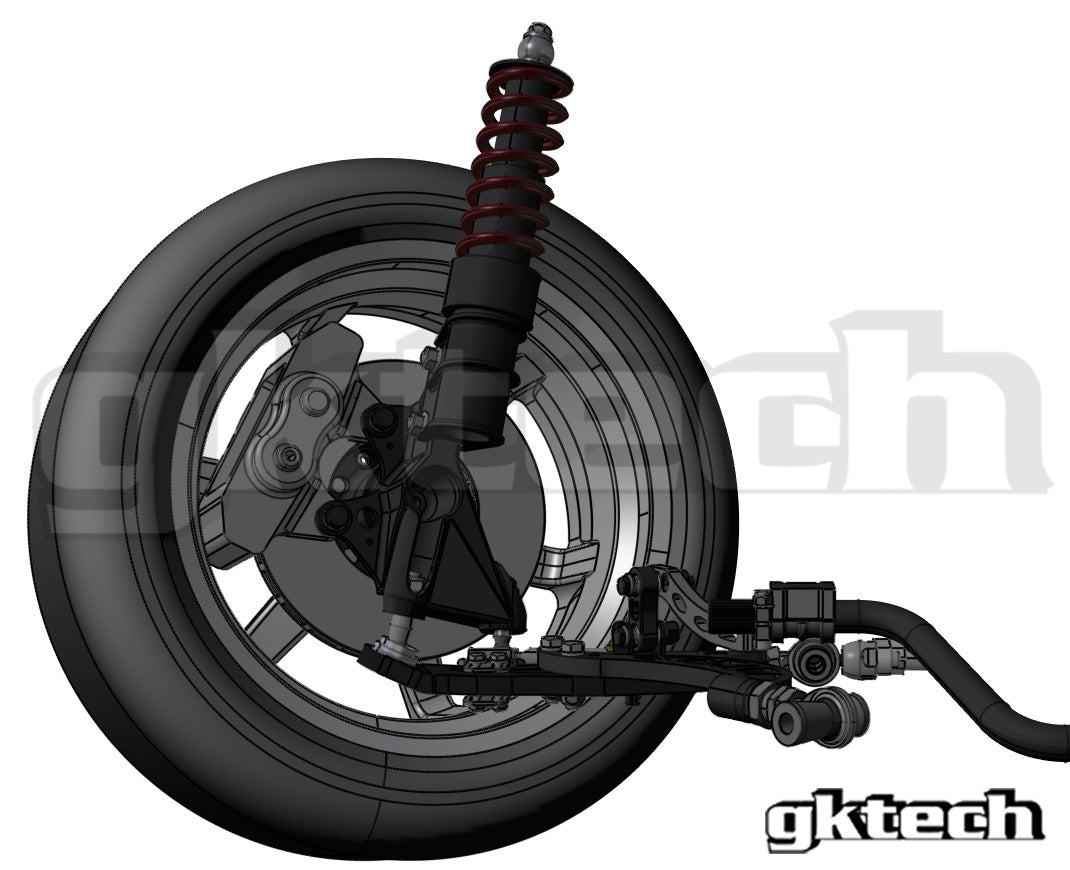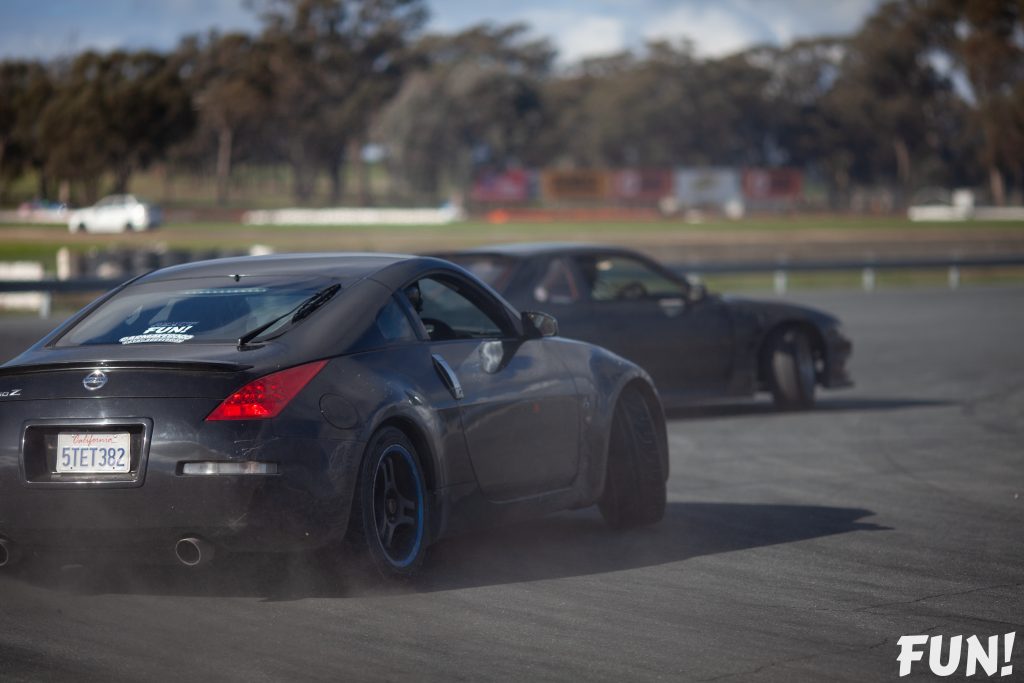For the Z33 (350Z) and Z34 (370Z) chassis, Nissan retained the tried and tested R200 rear differential platform. A large drawback which was introduced is that the rear subframe mounting solution was reduced from the previous dual stud design, seen in late model S and R chassis’, down to a single stud.
This single stud design and low mechanical properties of cast aluminum, coupled with the difficulty of casting without defects or porosity, results in a rear diff cover that is prone to catastrophic failure; as shown in image 1. This is especially common in high horsepower applications, which is made worse by high grip drift or drag setups.

The single stud design results in significantly larger loads being transferred through its mounting point when compared to a dual stud design. Additionally, a single stud results in a bending moment created from the torque of transmitting power to the ground. This would otherwise be countered by the secondary mounting point in a dual stud application. It is not uncommon for the stud to snap even though they are a high tensile M14 stud.

The easiest and by far the most common solution is to add some type of support bracing to the opposite side of the rear differential cover that the stud is on. There are countless ways to achieve this, however, all follow the same general layout and principle. That is, to mount to the differential cover using at least two rear cover bolts, followed by connecting this to another location on the subframe for the additional support. While ensuring that the bracket is strong enough to support the high forces that the Z-chassis differentials experience.


Our solution followed this simple formula. However, we designed our braces with maximum strength in mind while taking up as little space as possible. To achieve this, we mounted to the front side of the subframes to keep the differential brace tucked up high and to maximize ground clearance. Similarly, this also allows for maximum clearance for things like aftermarket exhausts, especially twin exhaust systems. This solution is simple, affordable and it works. In saying that, this product is still a band aid fix as the new mounting point is significantly offset from the bolts holding it to the cover. The least compromised solution is to move to a dual stud rear differential cover. Surprisingly, Nissan did make a dual stud rear differential cover which can be found in VQ40 equipped R51 Nissan Pathfinder’s and solid axle Frontier’s.

Great, problem solved you might say. But unfortunately, there hasn’t been an off-the-shelf way to install one of these covers, plus the fact they are getting increasingly hard to find. This led us to develop both a bolt in and weld in solution for the pathfinder cover along side our billet diff covers, but more on that later. This was hindered by Nissan updating the studs from M14 to M16 on the diff side and M12 to M14 on the subframe mounting side. Meaning that all rear diff bushes are required to be drilled out, even when using our custom made studs. This is due to a stud needing to seat in place using a taper on the M16 side rather than bottoming out on the threads internally which can lead to high stress concentrations in the casting.

Apart from this, you would assume that Nissan re-cycled the late model S/R chassis cover with the relevant updates to suit VQ drivelines; but you’d be wrong. They decided to update the hole spacing to nearly 20mm narrower! In doing so, this completely rules out the use of the Pathfinder cover on a Z33 diff and mounted into an S/R 2 bolt subframe, which has become an extremely popular conversion.
Another option is that of the Greddy cover. While it is unfortunately still cast, the cover has dual rear studs, slightly higher capacity, and cooling fins. Despite these benefits it has no bolt in solutions to take advantage of the dual rear studs. In saying that, they do retain a hole spacing that allows this cover to be used in S/R chassis subframes when utilizing our Z33 conversion bushings; so that’s a big bonus! These covers are getting harder to find and the Greddy website shows them as discontinued, another blow to the current dual stud options. Lastly, there were also some OEM style single stud billet replacement covers in the past that offered a decent improvement in strength. Yet these were short lived or bulk buy deals that are no longer available.


As a result, we saw a opportunity to give the community a one and done solution to the single diff stud problem. At the same time it would be irresponsible of us not to take advatage of the ability to completely redesign a diff cover and include as many additional features as possible. So, without any more stalling, we introduce the new Z33 and Z34 billet diff covers!

The process begun with a 3D scan of a rear differential cover, in this case, a Nismo finned version. From this, data such as the bolt pattern, ABS sensors, stud mounting, and OEM capacity can be established. This gave us a clear starting point to then develop the features and design requirements that we planned to offer. Which are as follows; add a dual stud location, maximize capacity increase, retain OEM oil control systems, additional heat dissipation and provisions for an oil cooler or sensors.

One very important initial step is to consider the material choice, this drives a substantial amount of the design considerations such as thickness, strength, and thread sizes/depths. The obvious choice here is the tried and tested 6061-T6 with its impressive strength characteristics for a light and easily machinable material, plus, its heat dissipation is a substantial improvement over a porous cast material that does not conduct heat very well.


Once the initial design is complete, rapid prototyping is then done with the use of FDM 3D printers and some unfortunate failed overnight prints ☹. This process allowed us to quickly identify that our initial expectations as to the amount of extra capacity gained were substantially limited by subframe and additional bracing. This led to the overall depth needing to be reduced and the diff cover bolts being extended to allow more internal volume (an additional 100cc). Compounding the additional capacity issue was the diff braces. The depth, shape and cooling fins would have all be heavily effected if the diff brace was retained. This led us to the difficult decision to sacrifice the ability to retain the use of a diff braces, in favor of additional capacity, cooling, visuals and the all-important preferred solution of ensuring the cover is mounted with dual studs. The final capacity increase we ended up with was 600cc.

A problem that does arises from chasing additional oil capacity is that of oil flow and control, something that is often overlooked by other billet cover manufacturers. The OEM rear differential cover is designed with the use of fluid flow dynamics to ensure that the crown gear can pick up and throw oil to the front and sides of the differential itself, which is crucial to ensuring an adequate amount of oil is supplied to the pinion gear and bearings throughout. Therefore, it is crucial to ensure that we keep the internal surfaces as close to the OEM as possible. To achieve this, we have incorporated a stainless steel baffle plate that mimics the OEM rear cover. By comparing the flow of the OEM cover and our billet cover with the additional baffle plate, we can confirm that the flow is as close to OEM as possible.
With the additional oil capacity, this allows for an increased ability to remove excess heat, meaning cooler oil temperatures during sustained hard driving (keep in mind that it will take slightly longer to warm up to operating temperature). On top of this, we have included an additional port above the fill hole that can be utilized as an oil return port for an external oil cooler, which will aid to control oil temperatures even further. This oil return port also feeds directly back into the sump of the cover through allowances in the baffle plate. The final feature that greatly benefits temperature control is that of the cooling fins, which when combined with the overall size increase, result in a 60% increase over OEM in surface area to dissipate heat.

With the diff brace compatibility removed due to the capacity increase as previously mentioned, we needed to develop subframe mounting solutions that were simple and easy. The most obvious of which is a weld in bushing that can be added to the subframe. This is easy on the steel Z34 (370Z) subframe, however, due to the Z33 (350Z) chassis utilizing an aluminum subframe and the added difficulty and skill associated with welding aluminum; we wanted another solution. That’s where we came up with the bolt in secondary bush, a super simple bushing that requires only a front and rear hole to be drilled using the supplied guide, both of which can be completed with the subframe still in the car!

Due to popularity of S/R chassis diff conversions using the far newer R200 differentials and driveshafts from a 350Z, we wanted to make sure that these guys weren’t left out! So, the dual stud spacing was designed to ensure that our pre-existing S/R conversion bush kit (plus an additional bush for the secondary stud) can be utilized without any modification. This gives a dual stud solution in all applications for the billet diff covers.
With the main features and components of the rear differential covers accounted for, the final step was all the small parts that are integral to the product being a complete and bolt in package. This included high strength grade 10.9 equivalent custom rear studs; custom aluminum drain plugs with sealing washers and magnets to catch any metal shavings; standard AN oil breather fittings and new hex drive bolts to suit the extended rear cover. Coupled with the retention of the OEM ABS sensors, this cover is a direct replacement to that of the OEM unit with no clearance or cutting required. What more could be asked for?

If you have any questions regarding the billet diff covers, the dual stud installation process or anything else covered in this blog post. Feel free to reach out to us at sales@gktech.com.au


